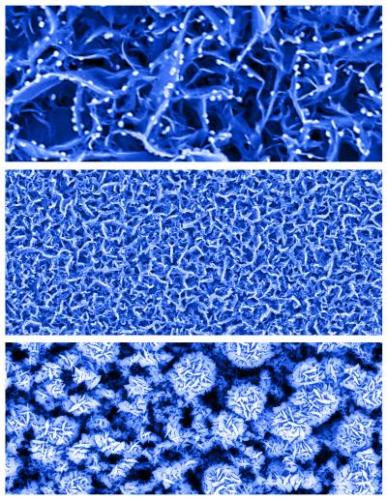By Kalwinder KaurAug 27 2012
A new type of biosensor for detecting even slight concentrations of glucose in urine, saliva, and tears has been developed by researchers. This device can be economically produced as it does not involve convoluted steps for processing.
 These color-enhanced scanning electron microscope images show nanosheets resembling tiny rose petals. The nanosheets are key components of a new type of biosensor that can detect minute concentrations of glucose
These color-enhanced scanning electron microscope images show nanosheets resembling tiny rose petals. The nanosheets are key components of a new type of biosensor that can detect minute concentrations of glucose
Along with Purdue experts D. Marshall Porterfield and Timothy Fisher, and other researchers at university's Birck Nanotechnology Center, this project was led by Anurag Kumar, Claussen and Purdue doctoral student.
The research has been described in a research paper in the journal Advanced Functional Materials, being published online this week.
Highlighted on the journal's cover, the paper’s authors include Claussen, Kumar, Porterfield, Fisher, and Purdue researchers Allison B. Hibbard, David B. Jaroch, and M. Haseeb Khawaja.
The sensor consists of three main parts such as platinum nanoparticles, nanosheet layers like tiny rose petals created from graphene, and the enzyme glucose oxidase.
Each petal includes graphene stacked in few layers. The petals’ edges include incomplete chemical bonds, supporting the attachment of platinum nanoparticles. Electrodes result by combining the platinum nanoparticles and nanosheet petals. The glucose oxidase then binds to the platinum nanoparticles. The enzyme is responsible for the conversion of glucose to peroxide, producing a signal on the electrode.
The technology also supports sensing different chemical compounds for testing other medical conditions, besides diabetes testing.
The sensor can differentiate between glucose and signals from other compounds causing interference in sensors such as acetaminophen, uric acid, and ascorbic acid existing in the blood. In contrast to glucose, those compounds are electroactive, producing an electrical signal even in the absence of an enzyme.
Glucose oxidase enables signal generation of glucose. This enzyme glucose oxidase has been included within commercial diabetes test strips for conventional diabetes meters for determining glucose with a prick of a finger.
Disclaimer: The views expressed here are those of the author expressed in their private capacity and do not necessarily represent the views of AZoM.com Limited T/A AZoNetwork the owner and operator of this website. This disclaimer forms part of the Terms and conditions of use of this website.